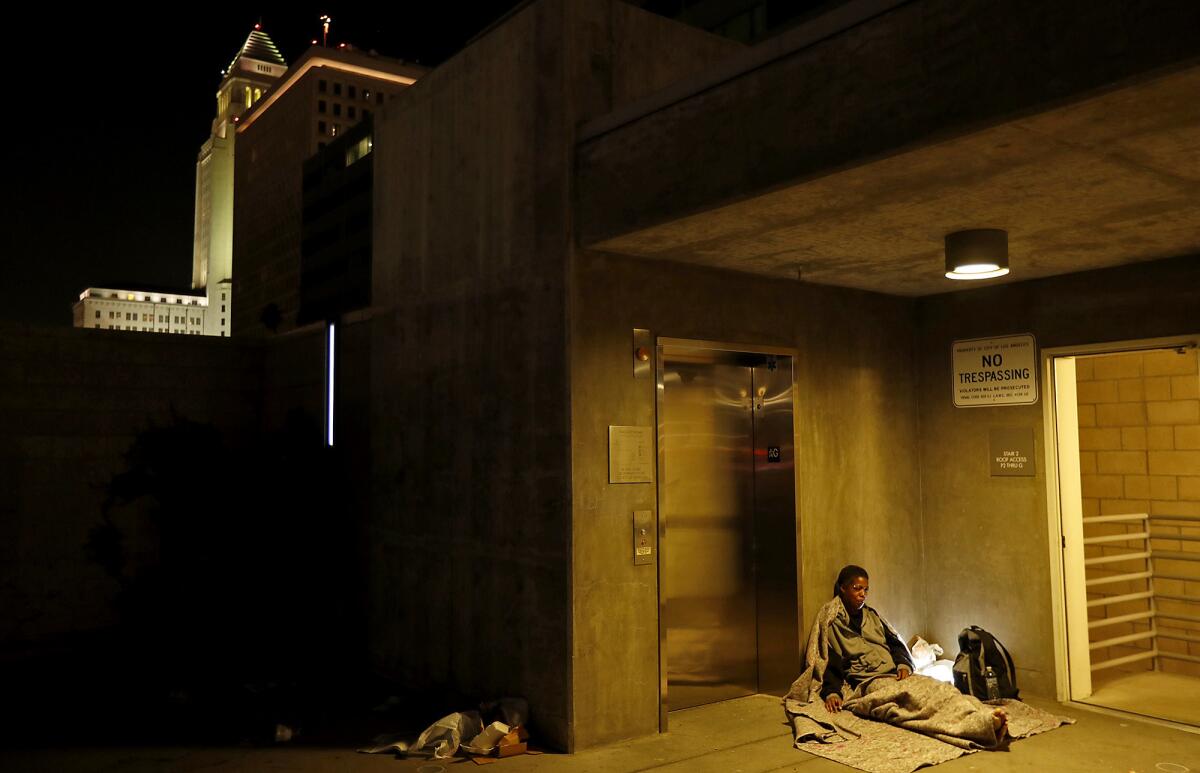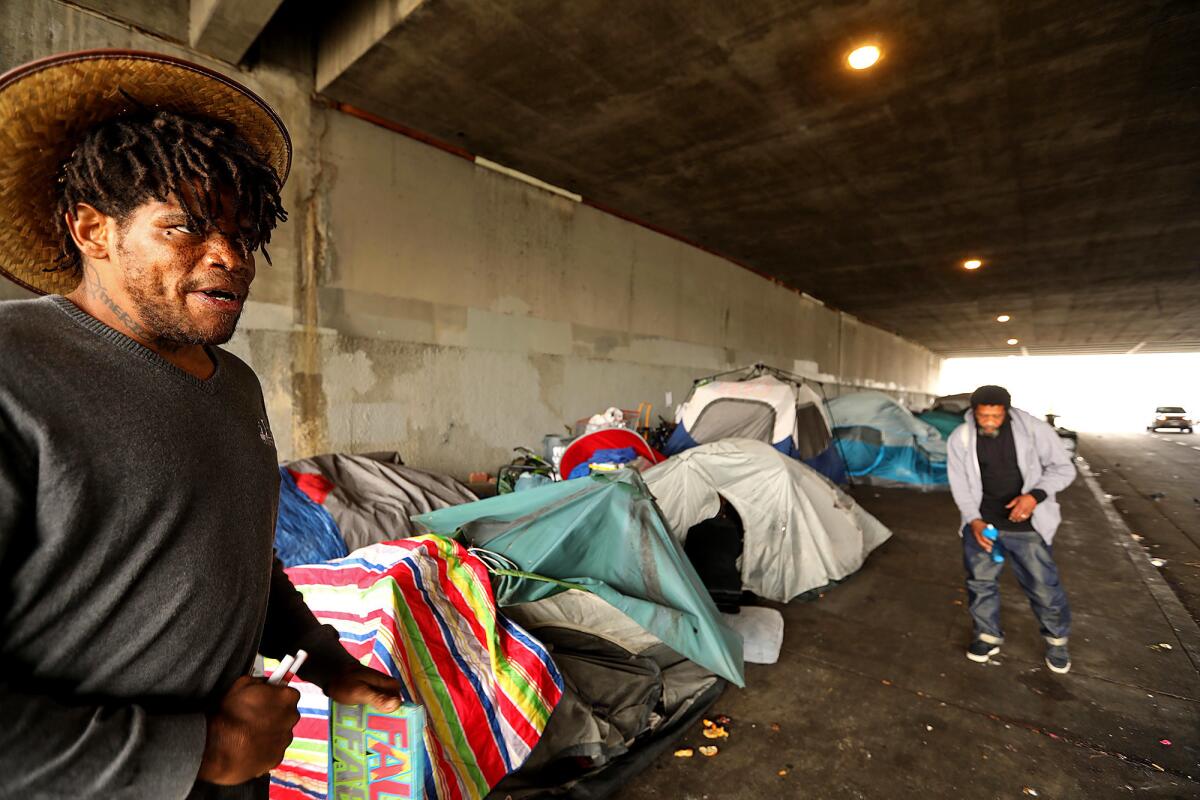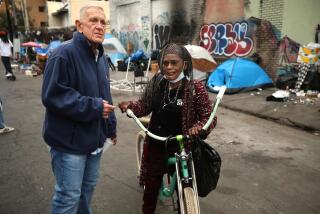Column: Garcetti is trying to face the challenge of homelessness, but he’s falling short

- Share via
One afternoon last week, on my way to watch the mayor tackle the humanitarian crisis of our time, I passed a dazed, barefoot man less than a block from City Hall. The temperature was in the mid-90s, the sidewalk was a skillet, and I wondered how much longer this poor soul would survive.
Two days later, on another trip to see the mayor, I saw a dozen or so people camped on the lawn south of City Hall. One was shaving near the fountain, as he often does. One slept on his back, his head in a box. Across the street, someone had dumped a pile of trash, and there were tents on the corner.
You know the scenes I’m talking about, wherever you live. Los Angeles has become a photo album of social breakdown.
A week ago I flogged local leaders, specifically L.A. Mayor Eric Garcetti, after the latest count showed a 16% increase in the homeless population despite a $600-million attempt to deal with the catastrophe. The mayor was not happy with my work and thought I should learn more about his work.
Fair enough.
The war room, as some refer to it, is on the 22nd floor of City Hall. Forty or so officials from various departments meet every Tuesday to review progress on interim and supportive housing projects. Stats are splashed across TV screens, department heads and City Council representatives share notes, the wheels grind.
Garcetti’s strengths were on full display. He was well-versed on most of the projects. There is no code, no procedural detail, no policy he has not deciphered. The mayor led the meeting with a smile and a friendly, collegial tone, but I wondered why he was there, sitting next to his homelessness chief, Deputy Mayor Christina Miller. Why not let her do the micromanaging and brief him later?
The data showed progress, but no speed records are being set. I would have liked to see Garcetti bark, snap towels, do something about the fact that in many council districts, more housing projects are overdue than on schedule. But Garcetti is a nice guy, maybe to a fault, and critics have long thought of him as averse to conflict and controversy.
The next morning, Garcetti did leave the handling of a daily briefing to Miller. In a city building east of downtown, two dozen or so representatives of the fire and police departments, Recreation and Parks, Sanitation and the Los Angeles Homeless Services Authority sat at computers in what actually did resemble a war room.
Giant screens displayed details about encampments, stats on citations for illegal dumping and outreach to homeless people. Each department laid out the day’s strategies and provided updates on projects big and small, such as efforts to assist a destitute family living in a park.
This is the kind of hard work that happens daily and makes a difference, and Garcetti and his team deserve credit. As I said last week, the achievements are many, and more than 20,000 people were housed last year.
But we’re losing ground, and there are ways to house people more quickly. After the morning meeting, I met with Ruth Hollman and Jason Robison of the Self-Help and Recovery Exchange, or SHARE, a nonprofit that housed 30 people with a $50,000 grant made possible by City Councilman Mike Bonin.
“We cannot build our way out of this,” said Hollman, who told me that at any given time, about 50,000 homes are vacant in the Los Angeles area. Her team finds homes on Craigslist and moves several SHARE clients into each one, offering some supervision and referrals to self-help groups. The rent is paid with a combination of Social Security benefits and a portion of income earned by working clients.
We visited a home in Gardena where nine middle-age women live. One, a chef, made lunch. Two women, both of whom work, told me how high rents drove them into homelessness. Another one told me she’s giving music lessons to neighborhood kids.
This isn’t THE answer, but it’s an example of one good alternative. Hollman said it’s been difficult to get support from City Hall to expand the model.
On Wednesday afternoon, Garcetti walked into First to Serve, a South Los Angeles shelter that partners with the city and county to house, feed and help hundreds of people. The mayor was met with a standing ovation from several dozen clients and employees, and the Rev. Richard Reed, the CEO, paid him tribute.
“We want to say thank you for your leadership and all the great work you do in the community,” Reed said.
Garcetti heard three clients tell their recovery stories, and he shed tears for each.
“I’m not honored to be your mayor, I’m honored to do this work because of the courage you show,” Garcetti said.
He spoke of being “driven to this mission,” said a few words in Spanish and called himself a man of faith, as if checking off boxes. He told the gathering he had served in the Navy, that he began working on skid row at 14, that he knocks on doors on weekends to hear what’s on people’s minds.
His father, former Dist. Atty. Gil Garcetti, walked into the room, and the mayor said his father grew up in South Los Angeles. The mayor spoke briefly about his family’s immigrant experience.
It sounded like a speech Garcetti might have been writing in his head all those months when he was testing out a possible run for the nation’s highest office, even as Los Angeles was swamped by income inequality, the affordable housing crisis and an epidemic of homelessness.
PHOTOS: Homeless people at almost every L.A. landmark illustrates the depth of the problem »

I heard Garcetti say more than once last week that although the city’s homeless numbers jumped 16%, the state number was twice as high, so the city is clearly doing something right. Watching him bask as First to Serve staff and clients thanked him and took pictures, I wondered if this is what you do when dreams of higher office evaporate; when you campaign for a school parcel tax that goes down in flames; and when even the most compassionate of L.A.’s residents wonder why you can’t do more about the public health threat from mounds of trash near encampments.
You delude yourself into thinking things are going pretty well.
On Tuesday, in an obvious response to critics, Garcetti sent a “Rising to the Challenge” letter to constituents.
“While we have housed more homeless Angelenos than ever before in our city’s history, it’s not enough. We must respond like it’s an earthquake — and do more, faster,” said Garcetti, who promised to be bold and said “it’s time for a seismic shift in how we confront the crisis.”
But there was nothing particularly seismic in his prescription. He vowed to “rally the private sector to do more,” to “cut red tape that delays housing,” to “add more showers, bathrooms, storage units and sanitation teams citywide,” to “strengthen the safety net that keeps people from becoming homeless in the first place,” and to ask anyone with a parking lot “to open it up to people who live in their vehicles.”
We needed a roar but we got a meow.
And much of what Garcetti vowed to do should have been in place long ago. A mayor with a strong hand doesn’t make promises; he makes demands, tolerates no excuses and gets rid of those who don’t measure up.
The inescapable truth of the matter is that when the $1.2 billion Garcetti helped deliver with Proposition HHH is gone and all the planned bridge housing and other projects are completed, we still figure to have tens of thousands of people on the street.
We’re in a tsunami without enough lifeboats.
“Since I arrived at this ivory tower called City Hall, I have been banging my head against the wall with this bureaucracy,” said Councilman Joe Buscaino, who wants the city to declare a state of emergency so it can work around some of the construction delays. He said he’d like Flyaway Homes, a company that’s converting shipping containers into homes and housing people for a third of the typical cost in a third of the typical time, to build 1,000 units on skid row. But bureaucracy is where good ideas go to die.
Kerry Morrison, a longtime activist in providing help for Hollywood’s most severely ill homeless people, shares Buscaino’s impatience. She is a Garcetti-appointed member of the HHH oversight committee on housing proposals. Like me, she’s heard more than one vow from Garcetti and those before him to end homelessness, only to watch the city lose ground.
“It’s frustrating to sit there and to have to only be presented with projects that look more like we’re approving luxury condos than housing for the homeless,” said Morrison, a reference to single units that take years to build and cost $500,000 or more apiece.
On Thursday, after walking past the people sleeping on the grounds of City Hall, I met with Garcetti for more than an hour. I told him I never doubted that he cares and works hard. He’s absolutely right when he says he’s done more than anyone, though that’s partly because years of underwhelming response magnified the crisis.
I acknowledged he’s dealing with state, federal and economic forces beyond his control. This is not all Eric Garcetti’s fault.
But doing a lot is not necessarily doing enough.
“The budget for homelessness is 25 times what it was when I started,” said Garcetti, arguing that he has stuck his neck out repeatedly, fought for more funding, helped put thousands of housing units in the pipeline and “built a coalition” that has planted seeds for a future in which the numbers come down dramatically.
As for declaring an emergency, he said he’s been advised that doing so would not bring significant additional power, and he’d still be bound by restrictions against things like building on contaminated soil. Garcetti told me he agrees we have to scale up, and he’s in talks with people who may provide tens of millions of dollars in private financing to support more construction by Flyaway Homes.
I reminded him that 18 months ago, he and I talked about there being no “buck stops here” agency when it comes to homelessness, because power is divided among city and county agencies. The Los Angeles Homeless Services Authority, Garcetti and L.A. County Supervisor Mark Ridley-Thomas said at the time, might need to be restructured to give it more authority.
That hasn’t happened, and Garcetti told me he doesn’t think it will, partly because a restructuring would be too complicated politically.
Then who would he say is in charge?
He is, he acknowledged.
“As your mayor,” Garcetti said in his Tuesday letter to constituents, “I take full responsibility for our response to this crisis.”
On Friday afternoon, I watched Garcetti take the microphone at Hollywood Adventist Church and deliver a pep talk to dozens of newly trained outreach workers, some of whom were once homeless. These workers, funded by the city and county, will take to the streets — the newest soldiers in an army of 800 — and try to bring homeless people out of encampments and into new housing units.
“I look at a city that is fighting for its soul right now,” he told them.
Garcetti told the outreach workers they’d be on the front lines in a city where more than 900 homeless people died last year, and he mentioned the barefoot man I told him I had seen near City Hall.
Given the energy in the room, you couldn’t help but feel a sense of hope.
But we need much more than that.
We need those who want a solution anywhere but in their own neighborhood to become part of the solution.
And we need the man in charge to follow through on his own promise and to urgently, swiftly, finally, rise to the challenge.
More to Read
Sign up for Essential California
The most important California stories and recommendations in your inbox every morning.
You may occasionally receive promotional content from the Los Angeles Times.











